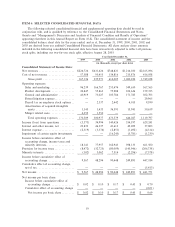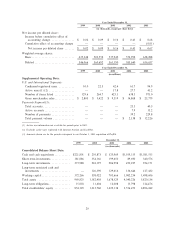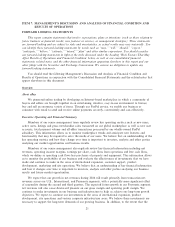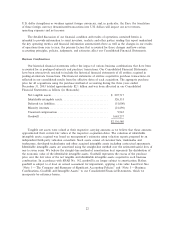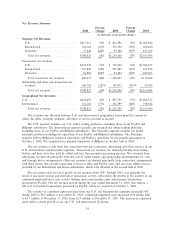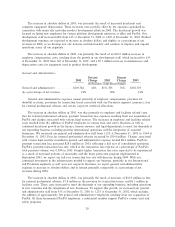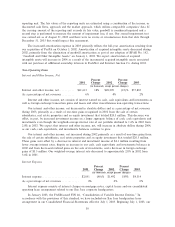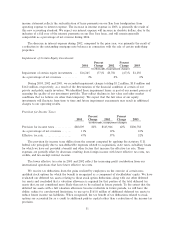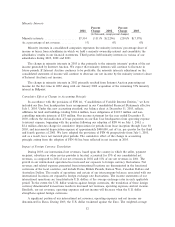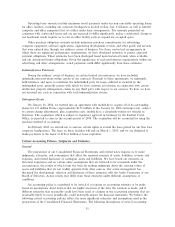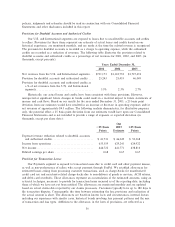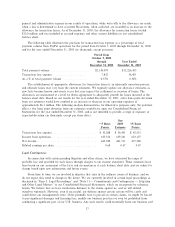eBay 2003 Annual Report Download - page 31
Download and view the complete annual report
Please find page 31 of the 2003 eBay annual report below. You can navigate through the pages in the report by either clicking on the pages listed below, or by using the keyword search tool below to find specific information within the annual report.
Patent Litigation Expense
Percent Percent
2001 Change 2002 Change 2003
(in thousands, except percent changes)
Patent litigation expenseÏÏÏÏÏÏÏÏÏÏÏÏÏÏÏÏÏÏÏÏÏ Ì N/A Ì N/A $29,965
As a percentage of net revenues ÏÏÏÏÏÏÏÏÏÏÏÏÏÏ Ì Ì 1%
Patent litigation expense during 2003 relates to the accrual of an August 6, 2003 court judgment
resulting from the MercExchange patent infringement lawsuit. See ""Note 11 Ì Commitments and
Contingencies'' to our Consolidated Financial Statements.
Payroll Tax on Employee Stock Options
Percent Percent
2001 Change 2002 Change 2003
(in thousands, except percent changes)
Payroll tax on employee stock options ÏÏÏÏÏÏÏ $2,442 64% $4,015 139% $9,590
As a percentage of net revenues ÏÏÏÏÏÏÏÏÏÏÏÏ 0% 0% 0%
We are subject to employer payroll taxes on employee gains resulting from exercises of non-qualiÑed
stock options. These employer payroll taxes are recorded as a charge to operations in the period in which
such options are exercised and sold based on actual gains realized by employees. The increases in 2003
and 2002 were primarily a result of larger individual gains recognized on stock option exercises by our
employees during periods in which our stock price was high relative to historic levels. Our results of
operations and cash Öows could vary signiÑcantly depending on the actual period that stock options are
exercised by employees and, consequently, the amount of employer payroll taxes assessed. In general, we
expect payroll taxes on employee stock option gains to increase during periods in which our stock price is
high relative to historic levels.
Amortization of Acquired Intangible Assets
Percent Percent
2001 Change 2002 Change 2003
(in thousands, except percent changes)
Amortization of acquired intangible assets $36,591 (56)% $15,941 218% $50,659
As a percentage of net revenues ÏÏÏÏÏÏÏÏÏ 5% 1% 2%
From time to time we have purchased, and we expect to continue purchasing, assets or businesses to
accelerate category and geographic expansion, increase the features and functions available to our users
and maintain a leading role in online trading. These purchase transactions may result in the creation of
acquired intangible assets and lead to a corresponding increase in the amortization expense in future
periods.
Intangible assets include purchased customer lists, trademarks and tradenames, developed technolo-
gies, and other intangible assets. We amortize intangible assets, excluding goodwill, using the straight-line
method over estimated useful lives ranging from one to eight years. We believe the straight-line method of
amortization best represents the distribution of economic value of the identiÑed intangible assets.
Goodwill represents the excess of the purchase price over the fair value of the net tangible and
identiÑable intangible assets acquired in a business combination. In accordance with SFAS No. 142,
goodwill is subject to assessment for impairment and is no longer subject to amortization. Rather, goodwill
is subject to at least an annual assessment for impairment, applying a fair-value based test. We evaluate
goodwill, at a minimum, on an annual basis and whenever events and changes in circumstances suggest
that the carrying amount may not be recoverable. Impairment of goodwill is tested at the reporting unit
level by comparing the reporting unit's carrying amount, including goodwill, to the fair value of the
29


